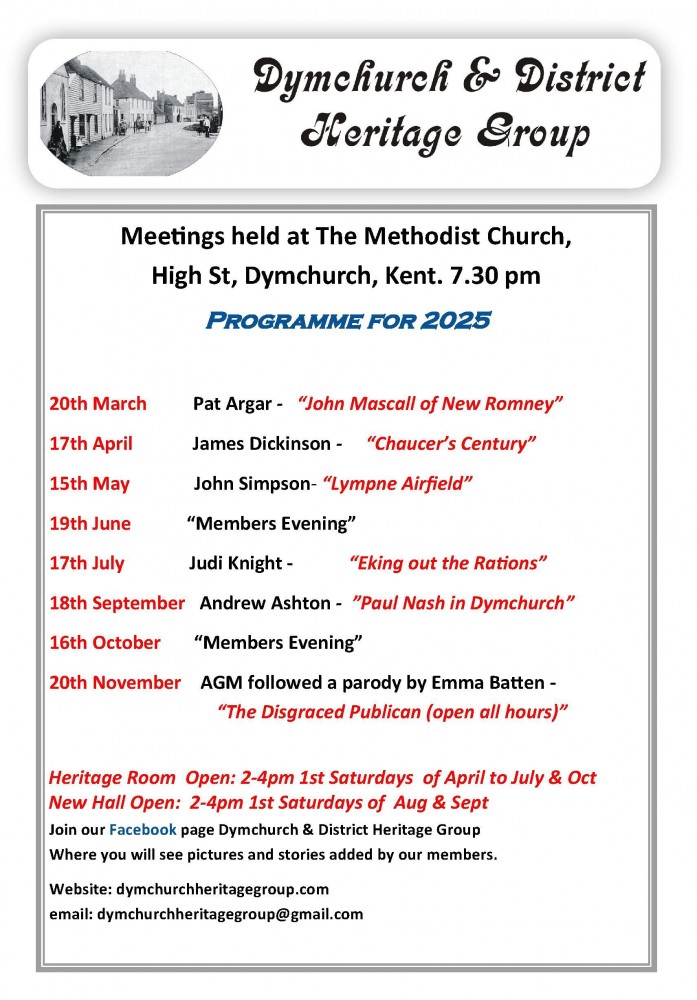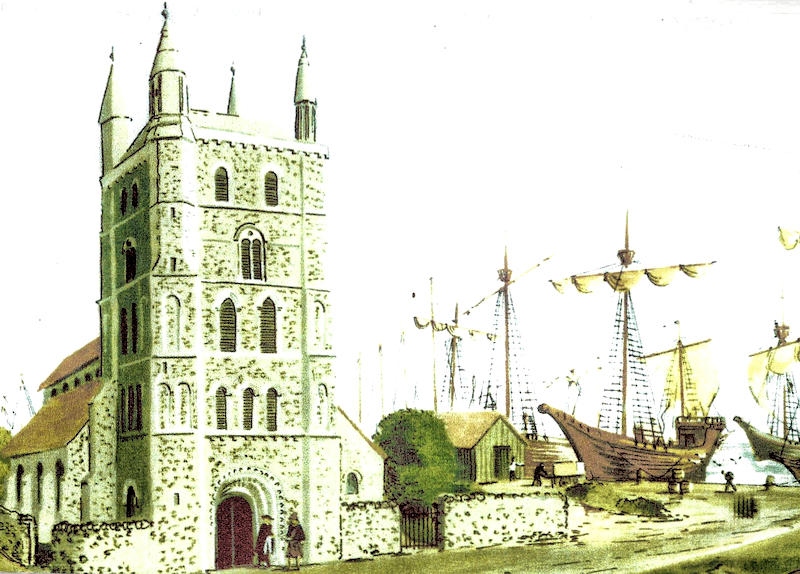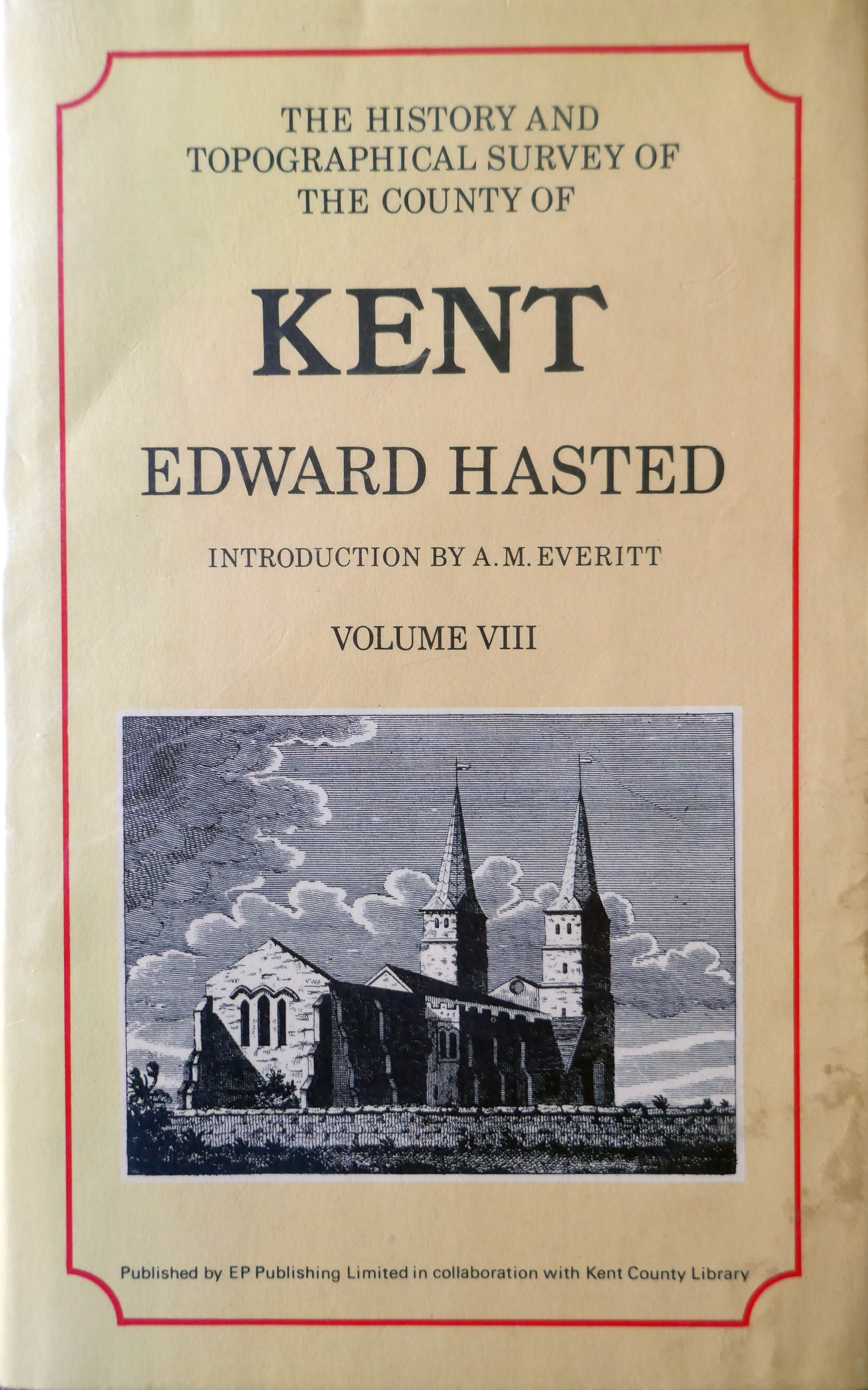History of Romney Marsh - The History Website of the Dymchurch and District Heritage Group
This site focuses on recording and presenting the history of Romney Marsh. It is essentially the story of a great storm, the reclamation of land from the sea, and the ongoing battle to drain the Marsh and keep the sea from reclaiming the land. Throughout the centuries all this was happening, life on the Marsh was centred around sheep, smuggling and defending England from invasion.
For information about the Dymchurch and District Heritage Group, including details of its programme of local history talks, opening times of the Heritage Room and special events see the Dymchurch & District Heritage Group website. The Programme of Talks for 2025 and the list of Books for Sale have been included below.
The Dymchurch & District Heritage Group on Facebook has many interesting local history posts, with contributions from all over the world.



Romney Marsh is a sparsely populated wetland area in Kent in the South East of England. It covers about 100 square miles. Criss-crossed with numerous watercourses, and with many areas lying below sea level, the Marsh has over time sustained a gradual level of reclamation, both through natural causes and by human intervention.
Romney Marsh is the largest coastal wetland on the south coast of England. With the English Channel as its eastern boundary, it is formed from several linked marshes: Romney Marsh proper forms the eastern portion, with the 'younger' Walland Marsh forming the majority of the western portion, and Denge Marsh to the south.
Its rich history derives from its formation from many small islands, its many medieval churches dating from 1100AD, through its changing landscape caused by the Great Storm of 1287, the raising of sheep and the smuggling of their fleeces to its military heritage from its defence of the country against the French and the Germans.
Known as the “Fifth Continent of the World” in recognition of its uniqueness, Romney Marsh is truly a land apart. Sheep graze green fields separated by a maze of ditches, the horizon punctuated by church towers. Famed for its emptiness, its sweeping skies and sense of solitude it is truly a unique and special place.
Today the Marsh is a peaceful place mostly devoted to farming, its quiet and flat lanes offering excellent walking and cycling - its churches provide a step back into history - its landscape supporting a variety of special wildlife. And known for Its distinctive coastline from the shingle of Dungeness to the sandy beaches at Dymchurch, all marked with reminders of why it is known as the Invasion Coast. ![]() Romney Marsh Today
Romney Marsh Today

The Port of New Romney AD 1200
Romney Marsh is known as The Fifth Continent. Thomas Ingoldsby, the pen name of 19th-century author and cleric Richard Harris Barham (sometime Rector of St Dunstan, Snargate), wrote in his The Ingoldsby Legends:
The World, according to the best geographers, is divided into Europe, Asia, Africa, America, and Romney Marsh.

Serve God, honour the King, but first maintain the Wall is an apt slogan for Romney Marsh. Penned by author Russell Thorndike in his Dr Syn novel 'The Scarecrow Rides', it epitomises the fact that Romney Marsh owes its existence to the Dymchurch Wall, which stops the sea from flooding the Marsh.

John Betjeman wrote about Romney Marsh:
Romney Marsh, on the Sussex border of Kent and close to the sea. Romney Marsh, where the roads wind like streams through pasture and the sky is always three-quarters of the landscape. The sounds I associate with Romney Marsh are the bleating of innumerable sheep and the whistle of the sea wind in old willow trees. The sea has given colour to this district: it has spotted with silver the oak posts and rails; it gives the grass and the rushes a grey salty look and turns the red bricks and tiles of Fairfield Church a saffron yellow.

.
Edward Hasted wrote about Romney Marsh in his book 'The History and Topographical Survey of the County of Kent' :
..Different have been the opinions of the origin of Romney Marsh, some asserting that it was once wholly covered by the sea, and deserted when that element had made its encroachments on other distant parts; and others, that it was only a large swamp, covered in many places by the tides at times, and by the waters of the river Limen or Rother, (called, at least that part of it which was near Romney, in archbishop Plegmund's grant beforementioned, Rumeneia,) which had then no banks to confine the waters of it from flowing over the lands adjoining to them, insomuch that both together made the greatest part of it, an uninhabitable morass...... Read more




















